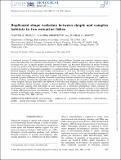Replicated shape variation between simple and complex habitats in two estuarine fishes
Author
RUEHL, CLIFTON B.; SHERVETTE, VIRGINIA; DEWITT, THOMAS J.
Abstract
A replicated pattern of habitat-associated morphology among different lineages may represent adaptive convergence. Deviation from the replicated (shared) pattern of diversification reflects unique (e.g. species specific) effects resulting from site- or species-specific selection, intrinsic factors (e.g. G matrix differences) or chance historical events (e.g. genetic drift). For two distantly-related estuarine fishes [Lagodon rhomboides (Sparidae; Linnaeus) and Leiostomus xanthurus (Sciaenidae; Lacepede)], we examined shared and unique instances of body shape variation between seagrass (complex) and sand (simple) microhabitats at four sites. We found extensive shape variation between microhabitats for both species. As a shared response, both species from sand had subterminal snouts and long caudal peduncles, whereas those from seagrass had terminal snouts and deep bodies. Unique responses involved a greater difference in Lagodon rhomboides head shape between microhabitats compared to L. xanthurus. Patterns of shape variation fit ecomorphological predictions for foraging in the respective microhabitats (simple versus complex) because deep bodies are expected for fish that must negotiate complex habitats and subterminal snouts facilitate benthic foraging common in barren habitats. Parallel differentiation between microhabitats simultaneously suggests that individuals of each species use a particular microhabitat within estuaries for development and the differentiation in shape represents adaptive convergence. Spatial variation in the magnitude of shape differences between microhabitats was an unexpected finding and suggests that phenotypic variation operates at multiple scales within estuaries.
Date
2011-05
Citation:
APA:
RUEHL, CLIFTON B., & SHERVETTE, VIRGINIA, & DEWITT, THOMAS J.. (May 2011).
Replicated shape variation between simple and complex habitats in two estuarine fishes.
,
(),
-
. Retrieved from
http://hdl.handle.net/10342/7999
MLA:
RUEHL, CLIFTON B., and SHERVETTE, VIRGINIA, and DEWITT, THOMAS J..
"Replicated shape variation between simple and complex habitats in two estuarine fishes". .
. (),
May 2011.
April 25, 2024.
http://hdl.handle.net/10342/7999.
Chicago:
RUEHL, CLIFTON B. and SHERVETTE, VIRGINIA and DEWITT, THOMAS J.,
"Replicated shape variation between simple and complex habitats in two estuarine fishes," , no.
(May 2011),
http://hdl.handle.net/10342/7999 (accessed
April 25, 2024).
AMA:
RUEHL, CLIFTON B., SHERVETTE, VIRGINIA, DEWITT, THOMAS J..
Replicated shape variation between simple and complex habitats in two estuarine fishes. .
May 2011;
():
.
http://hdl.handle.net/10342/7999. Accessed
April 25, 2024.
Collections

